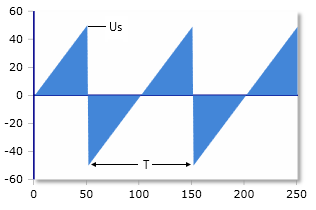RMS value of a sawtooth voltage
Calculator and formulas for calculating the RMS value of a sawtooth voltage
Sawtooth Voltage Calculator
Symmetrical sawtooth voltage
This function calculates the RMS value of a symmetrical sawtooth voltage. The mean value is always 0 volts for a symmetrical voltage.
|
|
Sawtooth voltage & parameters

Parameters
Basic formula
The RMS value is about 57.7% of the peak voltage.
|
|
Example calculations
Practical calculation examples
Example 1: Standard sawtooth voltage
Given: Us = 100V
Example 2: Audio signal generator
Given: Us = 10V (typical test signal)
Example 3: Oscilloscope time base
Given: Us = 5V (time base signal)
Ratios for sawtooth voltage
RMS ratio:
Mean value:
Formula for sawtooth voltage
What is a sawtooth voltage?
The RMS value (root mean square) of a sawtooth voltage can be calculated as follows when the voltage is in periodic form. The RMS value is defined as the DC value with the same thermal effect as the considered AC value. For symmetrical sawtooth voltages, it is calculated as follows.
Definition of RMS value
In a symmetrical sawtooth voltage, the voltage rises linearly from -Us to +Us over half a period, and then falls linearly from +Us to -Us over the other half period. The mean value of the voltage is always 0 volts.
RMS value formula
The mean value of the voltage is always 0 volts for symmetrical sawtooth voltages.
Properties of the sawtooth wave
The sawtooth wave has a linear slope over the entire period. Unlike the triangle wave, there is no symmetrical rise and fall time - the voltage rises (or falls) continuously over the entire period. In a symmetrical sawtooth voltage, the signal swings between -Us and +Us, so the mean value is zero.
Mathematical derivation
For a symmetrical sawtooth wave with period T:
Comparison with other signals
Practical applications
Signal generation
- Sweep generators
- Frequency wobbling
- VCO control
- Ramp signals
Measurement technology
- Oscilloscope time base
- Spectrum analyzer
- Linearity measurement
- ADC test patterns
Synthesizer
- Audio synthesizer
- Sound shaping
- Modulation sources
- Effect generators
Spectral properties
Harmonic components
A sawtooth voltage contains all harmonics with a specific amplitude distribution:
Design notes
Important properties
- Linearity: Constant slope over the entire period
- Symmetry: Mean value is zero for symmetrical sawtooth signals
- Harmonics: Contains all harmonics with 1/n amplitude drop
- Bandwidth: Sharp transitions require high bandwidth
- Reset: Instant return to the start value at the end of the period
- EMC: High harmonic content can cause interference
|
|